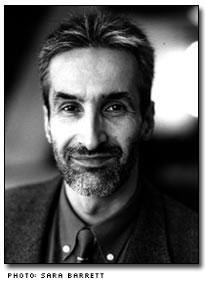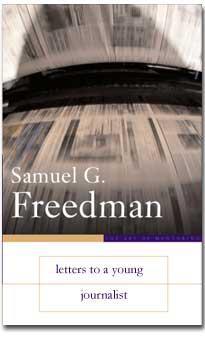
Samuel G. Freedman is an American author, journalist and professor at the Columbia University Graduate School of Journalism.
Samuel G. Freedman’s sage if sentimental book Letters to a Young Journalist is a meditation on what it takes and what it means to be a journalist.
His intention is not to provide the “specific, situational guidance” of a gifted editor, but rather to discuss the habits of mind, the work ethic and the moral ethos necessary for journalistic excellence.
Those looking for a practical how-to guide should look elsewhere. As suggested by the title, the book reads like a series of letters from an old hand to an eager rookie. (Think Sophie’s World for cub reporters.)
Freedman states his intentions early on:
“I want you to believe, as I believe, that you have chosen a profession of consequence and value, a profession that requires no apology, a profession that can make you happy.”
A return to journalism as ‘honest broker’
Make no mistake, Freedman is deeply nostalgic and unwavering in his belief that tradition is a crucial teacher. He is, after all, a product of long-standing institutions like the New York Times and Columbia University Graduate School of Journalism.
He defines journalism as “an honest broker of information” that has been “assiduously reported, verified for accuracy, and written without bias or partisanship” – a definition that emerged over the past century to dislocate its deeply partisan precursors.
“It was a radical step for journalists of the early 1900s to actually conceive of their work as a public service, untainted by personal belief, rather than an act of advocacy,” he writes.
Those who puzzle at journalism pre-Twitter may find Freedman’s anecdotes impossibly quaint, but to dismiss them is to refuse to look in the rearview mirror. (And, yes, objects are closer than they appear.)
He argues that we are witnessing a high-tech resurgence of a cynical, venal journalism that reverberates through “ideological echo chambers,” catering to those who would like to confirm what they already believe, and little else.
Sometimes he names names, blasting Fox News Channel as “a political movement masquerading as a news organization” and defends the fairness doctrine, however limited, as a superior standard to those that have replaced it.
“Journalism must do more than pander to prejudices,” he writes, adding that journalists cannot hope to reverse the trend toward disparagement and distrust of the media without renewing their commitment to excellence and public service.
Gone are the days that journalists, like Woodward and Bernstein, were widely regarded as heroes and news anchors, like Walter Cronkite, were trusted and respected. But the silver lining may be found in those that a battered profession now attracts.
“One thing you can say about the present unpopularity of journalism is that it drives out all the uncommitted,” Freedman points out, adding, “intellectual curiosity, vigorous research, acute analysis, and elegant prose will never go out of style.”
In defense of idealism
The unselfconscious sincerity of this book will not be palatable to everyone. Freedman admits he is not afraid to hold himself to a moral standard, or to sound naïve or sentimental.
He reassures fledgling reporters that their idealism and the clichéd desire to make the world a better place should not be so easily dismissed.
“[A]nyone who doesn’t enter journalism believing it is a moral enterprise might as well move straight on to speculating in foreign currency or manufacturing Agent Orange. There will be disappointments enough over the course of your career; your initial idealism must be a pilot light, flickering at times but never extinguished.”
Perhaps one of the most useful functions of the book is to point to common challenges and the reactions that quixotic young journalists, specifically, are likely to grapple with.
“Guilt is the sign of an active conscience. Undifferentiated compassion is a place to begin,” he says of navigating a world of issues that are knotty, gnarled and not so easily parsed.
“[The] most compelling journalism rarely takes the form of chronicling the battle between good and evil … The trickier and more valuable task is to illuminate the collision between good and good, or at least between competing versions and visions of what is good policy, a good community, a good citizen.”
Freedman encourages cub reporters to retain their humanity, to accept the burden of independent thought, to be wary of loyalty oaths and to realize that mistakes are rites of passage.
“To be witness, observer, and storyteller . . . is to reject the easy comforts of conventional wisdom and popular dogma. It is to welcome the dissonance of human events and to render that dissonance with coherence and style.”
He acknowledges that putting one’s readers, listeners and viewers first is not always easy, for instance when a community claims you as its own and/or expects you to further their interests.
“Many people will confuse an open ear with the promise of friendship, and some journalists, to their discredit, will encourage the misapprehension. The relationship between journalist and source, with both seeking some advantage from the other, is filled with ambiguity,” he says, blasting Janet Malcolm’s famous indictment of her fellow journalists.
(Although I quite enjoyed Malcolm’s book The Journalist and The Murderer, I agree that she was wrong – or at least not entirely right.)
Lessons learned the hard way
Freedman says he hinges his credibility on his failures more so than on his successes.
His cautionary tales and pointers get more specific as the book progresses. For instance: You should rarely use unnamed sources; don’t get addicted to approval; you will get “less stupid” over time; your first job won’t be the place you spend your life; read books as an apprentice, not a spectator; before you start an article, finish the sentence, “the heart of the matter is …”
He also stresses that preparing to be a journalist means preparing to be so much more, and questions the value of a standalone journalism education.
“I despair over every journalism class I took that could have been a class in political science or English literature or virtually anything else,” he admits. “All too few journalism programs, especially at the undergraduate level, strive to build your cultural and historical literacy and to imbue you with intellectual curiosity.”
This romantic regret was a theme throughout the book. Freedman – unlike the hard-nosed, strictly pragmatic editors of comic book newsrooms – encourages young journalists to do much more than read newspapers and pound pavement.
He argues that young people should also develop cultural literacy and an appreciation for the aesthetic experiences; seeking idols and inspiration in literature, film, jazz and “every great art.”
One subchapter that struck me, particularly because I see so many of my peers beating themselves up for struggling after graduation, was In Praise of Gradualism.
In it, Freedman argues that the important thing (especially in your twenties) is to develop your day-to-day skills – even if that means starting out in a smaller market.
“I can say that I have never seen a truly gifted young journalist go unrecognized. Maybe in the short run but never over time. There just isn’t that much excellence loose in the world that news executives can afford to ignore it.”
The P word we usually extol is passion, but Freedman says the key is patience. When you have the chance to work, whittle away your inexperience by honing your craft. And remember that the shine doesn’t last.
“Journalism is a business of proving yourself anew every single story, every single day.”
My overall thoughts about the book

Buy this can all be forgiven if you think of this text as a correspondence – affectionately written –and of Freedman as a man of letters.
I quite enjoyed many of his literary references. I loved the introduction to his chapter on reporting, which compared two main characters in Manuel Puig’s novel Kiss of the Spider Woman to reporting and writing.
“Valentin is the part of every journalist that wants to be a social reformer, and Molina is the part that longs to be an artist.”
But as much as I liked the metaphor, I can see how others might lose patience with such meandering passages. What is lateral thinking to some may seem pointless detours to others.
And though I was generally absorbed, there were times I doubted our tastes were aligned. For instance, in his chapter On Writing he recommended a “brilliant” description of an explosion from The Temple Bombing (page 121 of Freedman’s text) that I found far too verbose and image-saturated.
Still, despite these criticisms I walk away with positive feelings about this book. I enjoyed it, and I found myself feeling affection for Mr. Freedman, who is so earnest it’s hard not to like him.
I’d especially recommend it to journalists with artistic ambitions, and to those who appreciate not only the lasting relevance but also the dissimilarity of their elder’s experience. (Those who would visit a seasoned writer for a cup of coffee, and not mind if that cup became several.)
Finding meaning in the worldview of another person, especially those of other backgrounds and generations, is one of the cardinal skills of journalism – and there are enough kernels of wisdom in this relatively short text to make it plenty worth your while.
_______________________________________________
Have you read this book? What did you think? If you’re a fellow bookworm, look for me on GoodReads.com (Username: FabReads)
